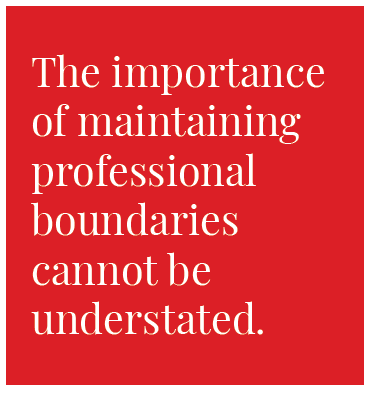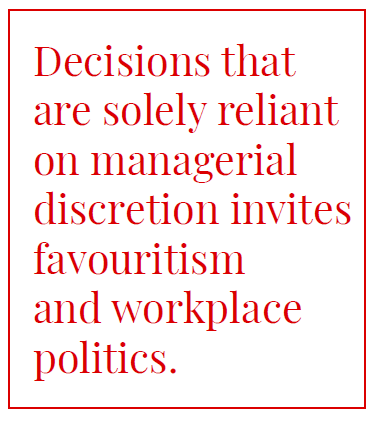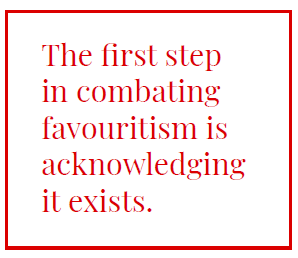Shedding light on workplace favouritism in health
What does workplace favouritism look like?
Imagine a workplace where your workload, access to career development opportunities, and leave approval depend solely on how much your manager likes you. This type of preferential treatment by someone in a position of power – we use ‘manager’ as a shorthand in this paper – is known as favouritism. And for over half our AST workforce, this issue of favouritism is very much a reality. [1]
Member experiences of favouritism have looked like:
“Management favours certain staff members, based on being of a similar profession or culture, or being personal friends with them. When resources are allocated, these ‘favourite’ staff members get preference, rather than it being based on who needs these resources most.”
“I’ve seen staff advanced to senior positions, while other staff with more knowledge and years of experience are overlooked.”
“Certain team members offered opportunities (that could be used for merit progression etc.) which other members aren’t even aware are available.”
“The senior who makes the roster tends to give the people she likes nicer schedules (e.g. less/no out of hours shifts). She also knows some people don’t like certain benches, so she doesn’t roster them in those areas, as they are quite physical (e.g. on your feet all day), which is not fair to the other staff.”
Other examples of favouritism include unfair task allocations, upholding double standards for performance or behaviour, not being impartial in workplace conflicts, selectively listening to and acting on employee contributions, and managers socialising exclusively with certain team members.
Favouritism arises from similarity or likeability biases stemming from personal connections, professional affiliations, shared cultural backgrounds, or other commonalities. One member pointed out “the old boys’ network” in some professions that perpetuates gender-based favouritism (and discrimination!). Nepotism based on familial relationships, is another type of favouritism.
While there’s a difference between favouritism towards an ‘in’ group versus discrimination against an ‘out’ group, these are usually two sides of the same coin. This is because often favouritism isn’t a zero-sum game. Special treatment usually comes at the expense of others in the team. An employee who gets “shoulder tapped” for a promotion means other qualified employees unfairly miss out. Where favouritism is based on gender, ethnicity, or other protected grounds, this veers into discrimination.
There is nothing wrong with having good managerial relationships with staff. The problem arises when personal connections are prioritised over competence and fair treatment, with no justifiable basis. A lack of known parameters or processes allows favouritism to flourish. However, even when this is not objectively the case, it is the perception of favouritism that matters because perception drives behaviour. [2]
Unsurprisingly, favouritism can be incredibly demoralising and reduces job satisfaction, engagement, and motivation. [3] It creates destructive hierarchies and seeds division within teams. It also drives group conflict and fosters hostility toward favoured colleagues. [4] In this way, favouritism is a work stressor which impacts worker wellbeing and their sense of belonging. Members told us:
“I feel that I’m treated differently to my colleagues… I feel unseen most of the time.”
“The stress of being constantly fearful of being replaced with a more ’favoured’ colleague, and working long hours had a very detrimental effect on my health and I am still trying to recover.”
Favouritism also creates a work climate that makes workers reluctant to speak up and even favoured employees can see this preferential treatment as tenuous and easily jeopardised, which has a silencing effect.
“There is clear favouritism within the department. If you have an opposing view to the leadership, you are viewed as being afraid of change.”
“Management seems to pick people who are in their favour and those that are not in their favour. I am luckily in favour. But I have witnessed other people being talked about behind their back and assumptions made about their quality of work. This results in clinicians being hesitant to approach management with difficulties they might have in fear of falling out of favour.”
When worker voice is silenced, employees withdraw their effort or leave the organisation entirely. [5]
How do we ensure managers don’t fall into the favouritism trap?
Managers promoted internally are at greater risk of showing favouritism, especially if they don’t establish new boundaries around existing friendships within the team. The importance of maintaining professional boundaries cannot be understated, even with seemingly innocuous actions such as routinely grabbing coffee with certain employees or connecting with staff on social media. This will always require a careful balancing act. [6]
In health, formal leadership training is generally not a prerequisite for stepping into a managerial role.
So, our immediate focus needs to be on equipping new and future managers with the competencies for fostering healthy work environments while avoiding dysfunctional behaviours such as favouritism. This includes training on leadership fairness and emotional intelligence, since manager self-awareness has been shown to reduce favouritism. [7]
Leadership training is especially important for AST practitioners who remain comparatively underrepresented in leadership positions. [8] This is due to the frequent lack of structured career pathways and the tendency for leadership roles – even those representing AST – to be advertised solely for professions such as nursing. Only recently are we seeing a shift away from profession-based leadership toward systems leadership; recognising that leadership in health “transcends professions”. [9] AST are well placed to be supported into such roles, given the multidisciplinary team-based nature of their work.
Beyond focusing on managerial actions alone we need to turn our attention to the organisational structures that breed favouritism such as the lack of a clear rewards and recognition system and discretionary approaches to policy implementation. While some discretion will always be needed to manage individual considerations, decisions that are solely reliant on managerial discretion invite in favouritism and workplace politics.
When clear HR management policies, guidelines, and procedures exist and are consistently enforced, staff are less likely to use political activities to influence hiring, rostering, leave approval, salary, and promotion outcomes. [10] In parallel, managers must be transparent and open in their communications with staff; being clear about the reasons behind decisions, rewards, and recognition wherever possible to ensure these can be objectively justified. Only then will this foster a culture of trust where staff can feel safe speaking out without a fear of retaliation.
Recommendations for organisations
Healthcare organisations must ensure new and aspiring managers are supported into their role with ongoing leadership training.
Team leader and managerial decision-making must also be guided by:
- Clear policies for leave approval, including sick and discretionary leave,
- Standard protocols for rostering practices, including fair rotation of employees across schedules and bench types,
- A robust and transparent career progression (and remuneration) framework, with CPD opportunities allocated equitably – agreeing a final AST career framework remains integral in promoting workplace fairness and equity,
- Standard processes for managing and escalating employee concerns, grievances, and conflicts, and
- Guidance on how to manage conflicts of interest, where these arise for managers.
Self-reflection questions
If you are a team leader, supervisor, or manager, take a minute to reflect on the following in your own practice:
- Since stepping into this role have I set clear professional boundaries in interactions with my team?
- Do I only socialise (e.g., go out to lunch) with certain members of my team?
- When an opportunity for training or career progression has come up, have I tended to prioritise staff I know well and like?
- Have I made an effort to show an interest in the lives of all my staff – for example, asking about their weekend or a recent holiday?
- Even I’m confident in my decisions as a leader, could I be more open and transparent in communicating my thinking to staff?
The first step in combating favouritism is acknowledging it exists. This requires managers to be fair, to be equipped with the necessary competencies to lead their teams, and to be guided by transparent and robust organisational processes. Our healthcare organisations clearly need better checks and balances to ensure favouritism doesn’t run rampant because when managers play favourites, everyone loses.
References
- APEX. (2025). APEX Te Whatu Ora Leadership Training Survey – Results, February 2025. Report available on request.
- Witherow, R. J. (2021). The Effects of Situational and Individual Differences on Employee Perceptions of Favoritism in the Workplace. (Master’s thesis, Middle Tennessee State University). Retrieved https://jewlscholar.mtsu.edu/server/api/core/bitstreams/0009339a-e85d-47c6-b156-36f83d67652b/content
- Akuffo, I. N., & Kivipõld, K. (2021). Authentic leadership competences and positional favouritism: Impact on positive and negative organisational effectiveness. International Journal of Applied Decision Sciences, 14(1), 81-104. doi: 10.1504/IJADS.2021.112927
- Lasisi, T. T., Constanţa, E., & Eluwole, K. K. (2022). Workplace favoritism and workforce sustainability: An analysis of employees’ well-being. Sustainability, 14(22), 14991. doi: 10.3390/su142214991
- Vveinhardt, J., & Bendaraviciene, R. (2022). How do nepotism and favouritism affect organisational climate? Frontiers in Psychology, 12(710140), 1-10. doi: 10.3389/fpsyg.2021.710140
- Blackwood, K., D’Souza, N., & Sun, J. (2019). Understanding Management Competencies for Managing Bullying and Fostering Healthy Work in Nursing. Auckland: Healthy Work Group, Massey University. Retrieved https://mro.massey.ac.nz/handle/10179/15565
- Akuffo, I. N., & Kivipõld, K. (2019). Influence of leaders’ authentic competences on nepotism-favouritism and cronyism. Management Research Review, 43(4), 369-386. doi: 10.1108/MRR-02-2019-0078
- Mizzi, L., & Marshall, P. (2024). Inequitable barriers and opportunities for leadership and professional development, identified by early-career to mid-career allied health professionals. BMJ Leader, 8(3), 1-8. doi:10.1136/ leader-2023-000880
- George, R. K., & Webster, K. (2021). The future of Allied health leadership in New Zealand-Aotearoa: A literature review. Asia Pacific Journal of Health Management, 16(2), 16-27. doi: 10.24083/apjhm.v16i2.743
- Paarima, Y., Kisinna, A. A., & Ofei, A. M. A. (2024). Perceived organizational politics: Implications for nurses’ stress and job satisfaction. International Journal of Africa Nursing Sciences, 20(2024), 1-8. doi: 10.1016/j.ijans.2024.100686







